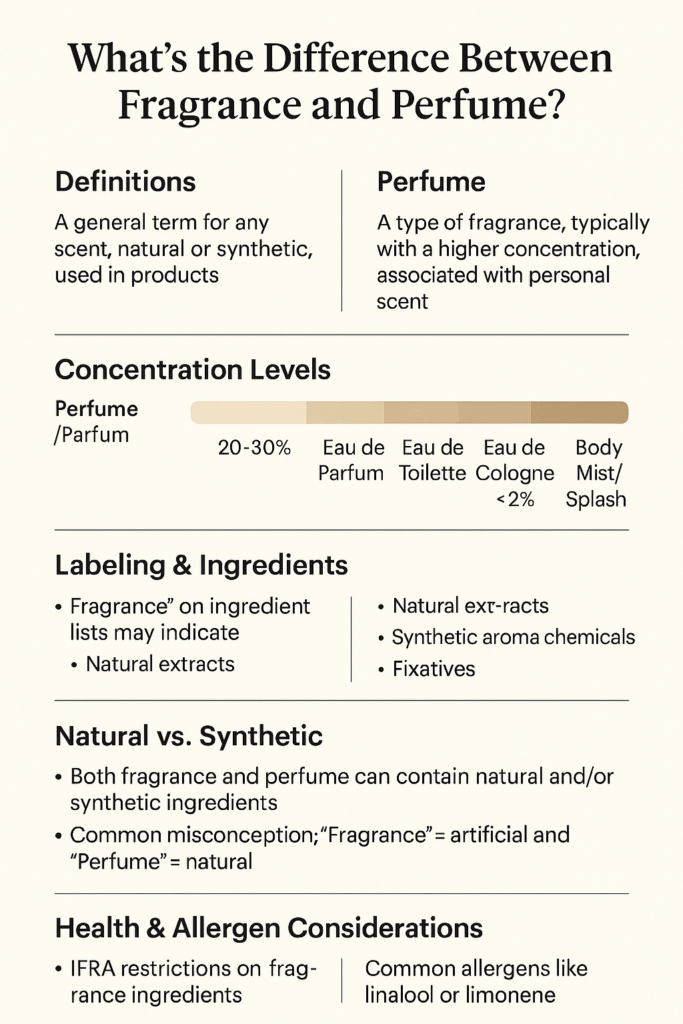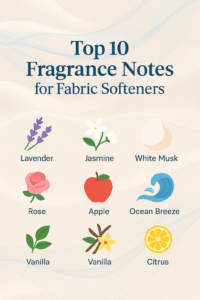What’s the Difference Between Fragrance and Perfume?
Understanding Terminology, Usage, and Safety in the Scent Industry
🔍 Introduction: Why the Confusion Exists
In the world of personal care, cosmetics, and fine fragrances, the terms “fragrance” 和 “perfume” are often used interchangeably. You’ll find them on labels, marketing materials, and ingredient lists — but do they really mean the same thing?
The short answer: No.
While both refer to scented substances, they differ in definition, usage, concentration, and regulatory context. This article unpacks those differences to help consumers make informed decisions and brands communicate clearly.
1️⃣ Definitions: Fragrance vs. Perfume
✅ What is “Fragrance”?
“Fragrance” is a broad, general term that refers to any scent added to a product — whether natural or synthetic. It may include essential oils, aroma chemicals, solvents, stabilizers, and fixatives. In regulatory terms (such as FDA labeling), “fragrance” is often treated as a trade secret, meaning its exact components don’t have to be disclosed.
Source: U.S. FDA – Fragrance Ingredients
✅ What is “Perfume”?
“Perfume” (or Parfum) refers more specifically to a type of fragrance with a higher concentration of aromatic compounds, typically used in personal scent products. It often carries a luxury or fine fragrance association, with carefully layered top, heart, and base notes.
2️⃣ Concentration Levels and Perfume Types
Perfume isn’t a single product — it comes in various strengths depending on the concentration of fragrance oil in the base (usually alcohol or water):
| Product Type | Fragrance Oil Concentration | Longevity | Common Use |
|---|---|---|---|
| Parfum (Perfume) | 20–30% | 6–8 hours | Luxury fine fragrance |
| Eau de Parfum (EDP) | 15–20% | 4–6 hours | Premium personal care |
| Eau de Toilette (EDT) | 5–15% | 2–4 hours | Everyday use |
| Eau de Cologne (EDC) | 2–5% | ~2 hours | Light, refreshing sprays |
| Body Mist/Splash | <2% | <1 hour | Cosmetics, skincare |
Source: Fragrance Foundation UK
The key takeaway: “Perfume” is a subcategory of fragrance, defined by concentration and purpose.
3️⃣ Labeling & Ingredients: What “Fragrance” Means in Cosmetics
On product ingredient lists, especially in skincare or household items, you’ll often see the label:
Fragrance (Parfum)
This refers to a mixture of many aromatic compounds (up to hundreds), blended to create a specific scent experience. These blends may include:
- Essential oils (e.g., lavender, lemon, eucalyptus)
- Synthetic aroma molecules (e.g., linalool, benzyl salicylate)
- Fixatives to prolong scent
- Stabilizers to enhance shelf life
According to the International Fragrance Association (IFRA), most modern fragrance formulas are 80–90% synthetic, due to consistency, safety, and cost.
Source: IFRA – Transparency and Safe Use
4️⃣ Natural vs. Synthetic: Breaking the Myth
It’s a common myth that “perfume” is always natural or luxurious, and “fragrance” is synthetic and harsh. In reality:
- Both perfume and fragrance can be natural or synthetic.
- High-end perfumes often include synthetics to stabilize or enhance natural notes.
- Many “fragrance-free” products still contain masking fragrances to neutralize unwanted base odors.
Natural doesn’t always mean safe, and synthetic doesn’t always mean toxic. It’s about the specific ingredient and concentration.
Source: DermNet NZ – Fragrance Allergy
5️⃣ Health & Allergen Considerations
Fragrance is one of the top cosmetic allergens worldwide. Some components — whether natural (like limonene) or synthetic — can cause:
- Contact dermatitis
- Asthma reactions
- Headaches or migraines
In the EU and under IFRA guidelines, 26 fragrance allergens must be declared if they exceed certain thresholds.
To minimize risk, sensitive consumers can choose:
- “Fragrance-free” (note: not always truly unscented)
- “Hypoallergenic” or “Allergen-free” labeled products
- Products with disclosed essential oil-only formulations
6️⃣ How Brands Use These Terms Strategically
In marketing, brands may strategically choose between “fragrance” and “perfume” to target specific audiences:
| Term Used | Brand Perception | Common in |
|---|---|---|
| 香水 | Luxury, elegant | Fine fragrance, niche perfume |
| Fragrance | Functional, generic | Cleaning, body care, skincare |
Private-label brands and OEM manufacturers should be mindful of regulatory labeling while also aligning terminology with brand positioning.
✅ Conclusion: Which Term Should You Use?
- “Fragrance” is a technical umbrella term, used across product types.
- “Perfume” is a specific, high-concentration type of fragrance, usually personal.
- For sensitive users: Always read ingredient labels and watch for known allergens.
- For brands: Know the difference — and use it strategically in product development and compliance.
🧠 Quick Recap (TL;DR)
| 特点 | Fragrance | 香水 |
|---|---|---|
| Meaning | Any scent blend in products | High-concentration scent for skin |
| Usage | In cosmetics, cleaning, skincare | In personal fine fragrance products |
| Labeling | Broad, often undisclosed | May be specified with concentration |
| Composition | Natural + synthetic mix | Often synthetic + essential oils |
| Risk of Allergy | Present in both | Present in both |

